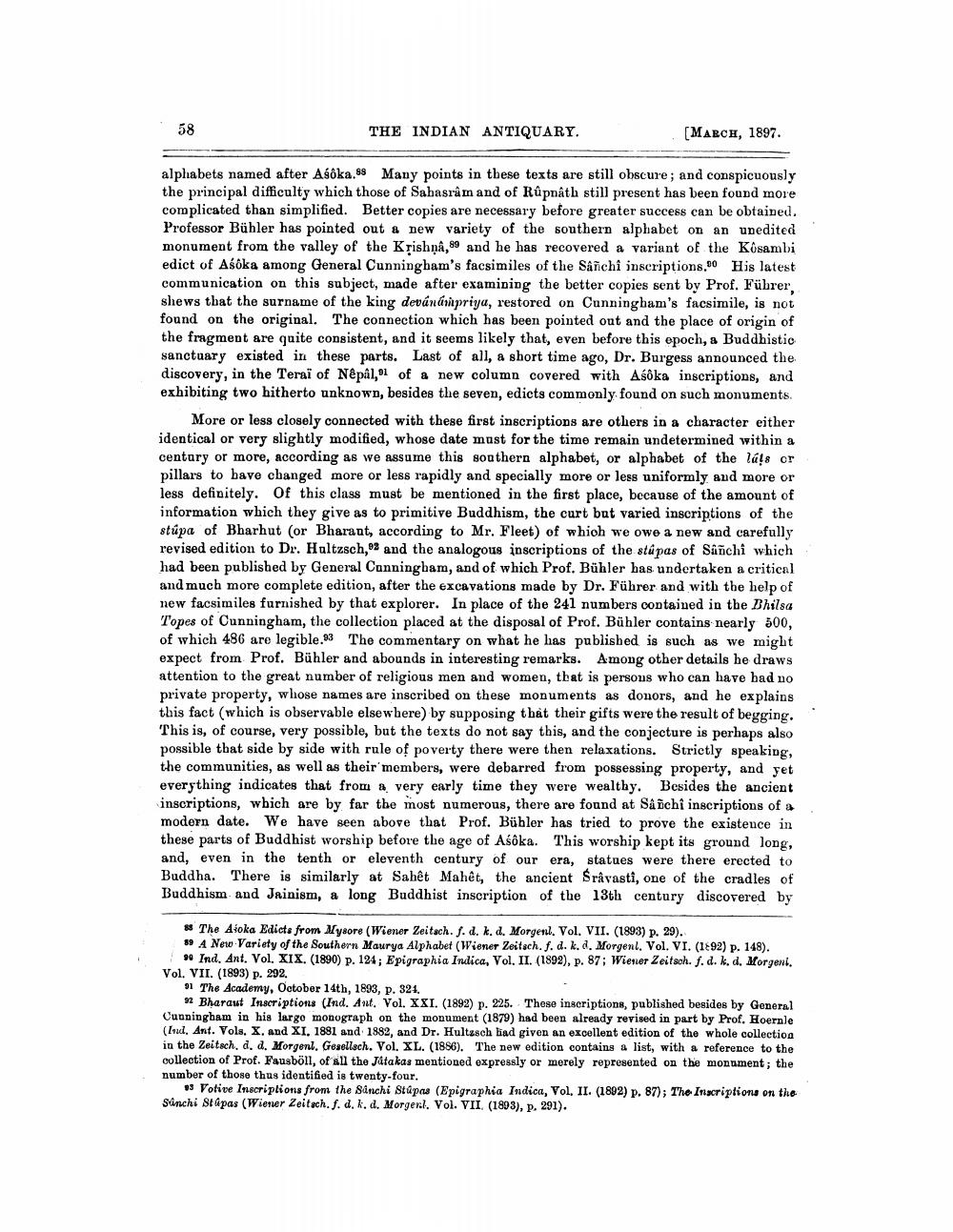________________
58
THE INDIAN ANTIQUARY.
[MARCH, 1897.
alphabets named after Asoka. Many points in these texts are still obscure; and conspicuously the principal difficulty which those of Sahasram and of Rûpnâth still present has been found more complicated than simplified. Better copies are necessary before greater success can be obtained. Professor Bühler has pointed out a new variety of the southern alphabet on an unedited monument from the valley of the Krishņâ,89 and he has recovered a variant of the Kosambi edict of Asoka among General Cunningham's facsimiles of the Sanchi inscriptions.00 His latest communication on this subject, made after examining the better copies sent by Prof. Fübrer, shews that the surname of the king devánárpriya, restored on Cunningham's facsimile, is not found on the original. The connection which has been pointed out and the place of origin of the fragment are quite consistent, and it seems likely that, even before this epoch, a Buddhistio sanctuary existed in these parts. Last of all, a short time ago, Dr. Burgess announced the discovery, in the Terai of Nepal, øl of a new column covered with Asoka inscriptions, and exhibiting two hitherto unknown, besides the seven, edicts commonly found on such monuments.
More or less closely connected with these first inscriptions are others in a character either identical or very slightly modified, whose date must for the time remain undetermined within a centary or more, according as we assume this southern alphabet, or alphabet of the láts or pillars to bave changed more or less rapidly and specially more or less uniformly and more or less definitely. Of this class must be mentioned in the first place, because of the amount of information which they give as to primitive Buddhism, the curt but varied inscriptions of the stúpa of Bharhut (or Bharant, according to Mr. Fleet) of which we owe a new and carefully revised edition to Dr. Haltzsch, 92 and the analogous inscriptions of the stúpas of Sanchi which had been published by General Canningham, and of which Prof. Bühler has undertaken a critical and much more complete edition, after the excavations made by Dr. Führer and with the help of new facsimiles furnished by that explorer. In place of the 241 numbers contained in the Bhilsa Topes of Cunningham, the collection placed at the disposal of Prof. Bühler contains nearly 500, of which 486 are legible.93 The commentary on what he has published is such as we might expect from Prof. Bühler and abounds in interesting remarks. Among other details he draws attention to the great number of religious men and women, that is persons who can have had no private property, whose names are inscribed on these monuments as donors, and he explains this fact (which is observable elsewhere) by supposing that their gifts were the result of begging. This is, of course, very possible, but the texts do not say this, and the conjecture is perhaps also possible that side by side with rule of poverty there were then relaxations. Strictly speaking, the communities, as well as their members, were debarred from possessing property, and yet everything indicates that from a very early time they were wealthy. Besides the ancient inscriptions, which are by far the most numerous, there are found at Sa nchi inscriptions of a modern date. We have seen above that Prof. Bübler has tried to prove the existence in these parts of Buddhist worship before the age of Asoka. This worship kept its ground long, and, even in the tenth or eleventh century of our era, statues were there erected to Buddha. There is similarly at Sahêt Mahêt, the ancient Sråvasti, one of the cradles of Buddhism and Jainism, a long Buddhist inscription of the 13th century discovered by
# The Atoka Edicta from Mysore (Wiener Zeitsch. f. d. k. d. Morgenl. Vol. VII. (1893) p. 29). 89 A New Variety of the Southern Maurya Alphabet (Wiener Zeitsch.f. d. k. d. Morgenl. Vol. VI. (192) p. 148).
90 Ind. Ant. Vol. XIX. (1890) p. 124, Epigraphia Indica, Vol. II. (1892), p. 87: Wiener Zeitsch. f.d. k. d. Morgenl. Vol. VII. (1893) p. 292.
91 The Academy, October 14th, 1893, p. 321.
92 Bharaut Inscriptions (Ind. Ant. Vol. XXI. (1892) p. 225. These inscriptions, published besides by General Cunningham in his largo monograph on the monument (1879) had been already revised in part by Prof. Hoernle (Iul. Ant. Vols. X, and XI. 1891 and 1982, and Dr. Hultasch tiad given an excellent edition of the whole collection in the Zeitsch, d. d. Morgenl. Gesellsch. Vol. XL. (1856). The new edition contains a list, with a reference to the collection of Prof. Fausböll, of all the Jatakas mentioned expressly or merely represented on the monument; the number of those thus identified is twenty-four.
3 Votive Inscriptions from the Sanchi Stapas (Epigraphia Indica, Vol. II. (1802) p. 87); The Inscriptions on the Sinchi stapas (Wiener Zeituch. f. d.k. d. Morgenl. Vol. VII. (1803), p. 291).




